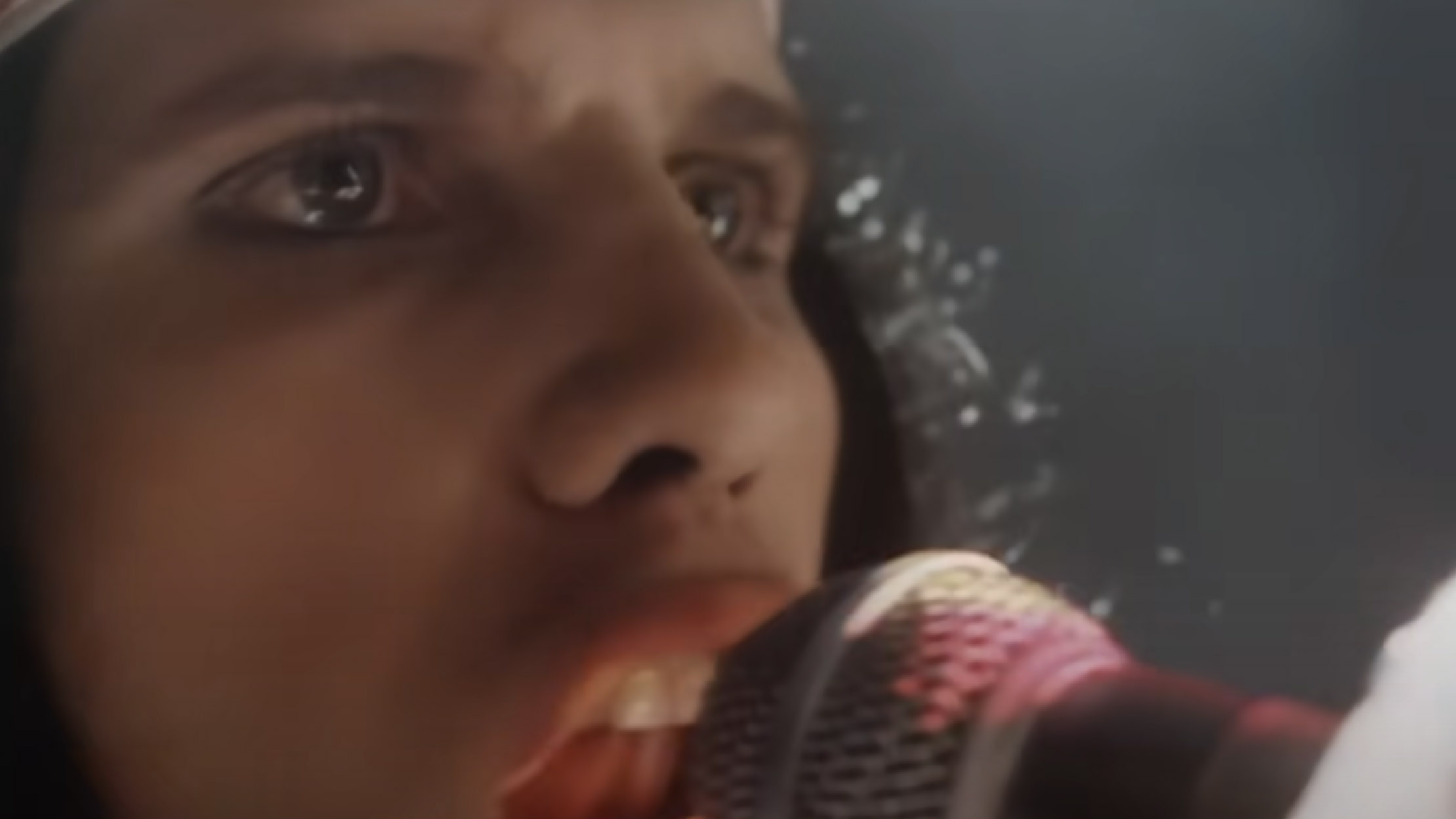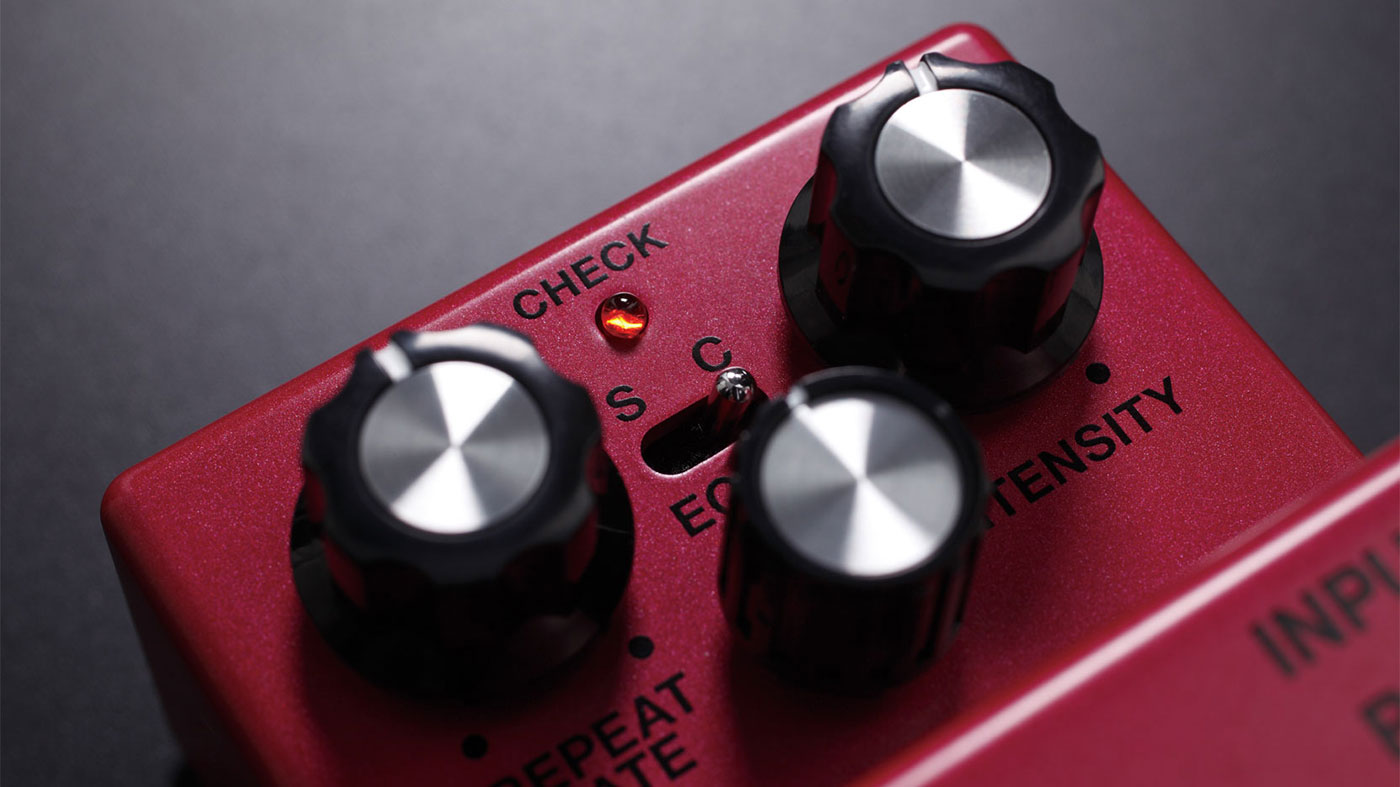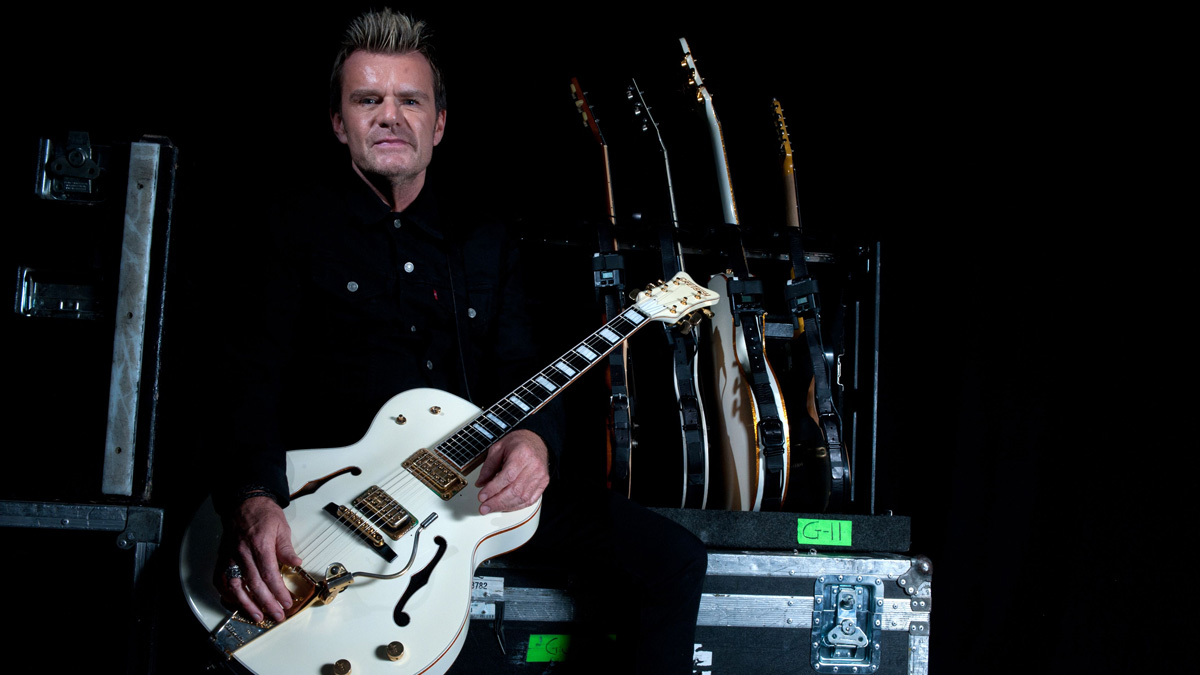
On 21 December 1985, the four members of The Cult walked onto the sound stage of NBC’s late-night Saturday Night Live TV show and launched into She Sells Sanctuary, a song the band had released as a single back in May of that year. This was already a hit in the UK, as was the band’s second album Love, on which the track appeared.
Their SNL show was a powerful performance. Visually, the band drew heavily on the elegantly wasted 70s rock star shtick that was still too fresh in the collective memory to be deemed ironic or cool. Frontman Ian Asbury styled himself as a scarf-festooned rock god, with a look that fell somewhere between Jim Morrison, Robert Plant and Steve Tyler. Guitarist Billy Duffy meanwhile, sporting dynamic peroxide quiff, dark tailored frock coat, black leather trousers and a Gretsch White Falcon, cut an equally striking figure.
Sonically, The Cult eschewed the subtleties that defined many indie artists of the time. On this, their second album, they went straight for the sonic jugular, producing a big, spacious and crisp anthemic rock sound. She Sells Sanctuary is not only the stand-out track on their Love album, it eclipses all others as the defining, pivotal song of the band’s career. It is the song that propelled The Cult towards a global audience. Almost 40 years on from its release, it remains a soaring, enduring anthem.
The Cult began life as Southern Death Cult, a post-punk band formed by singer Ian Astbury in Bradford in 1981. The band built up a loyal following among the emerging goth rock movement, recording a John Peel session in May 1981, signing to Beggars Banquet subsidiary indie label Situation Two, before breaking up in February 1983.
Two months later. Asbury teamed up with guitarist Billy Duffy to form Death Cult. Manchester-born Duffy had started out in a band called the Nosebleeds with the young Morrissey, and later went on to join Theatre Of Hate. The latter band’s drummer, Nigel Preston, was drafted into Death Cult along with a bassist from Harrow, called Jamie Stewart.
In a bid to tone down their goth background, the band shortened their name even further to simply The Cult in January 1984. Days later, delivered a stellar performance on Channel 4’s acclaimed music TV show The Tube.
Led Zeppelin were a clear influence on the band and like Zep, they sought to hone their chops out of the UK, in Scandinavia during July 1983. “The first gig I ever did with The Cult was in a club in Oslo called Rats,” Duffy told Roland.com “We thought to emulate Led Zeppelin and play our first shows outside the critical gaze of the UK.”
The band went on to record their debut album Dreamtime at the now legendary Rockfield Studios, in Monmouth, Wales. Duffy and Astbury were the band’s songwriters and many of those early songs, such as Horse Nation and Spiritwalker, reflected Astbury’s interest in Native American themes. Stylistically, the album was dark, dramatic and moody. It reached No.21 in the UK Albums chart.
Major tours followed, including support slots with Big Country in the UK and The Mission in Europe. By 1985, the band were embracing more fluid 60s influences and shifting towards a harder rock sound. This would be evident on their second album Love and the single that preceded it, She Sells Sanctuary.
The choice of studio for the recording of the song was Olympic Studios, in Barnes, London, a legendary facility for landmark albums by artists such as The Stones, The Who and Led Zeppelin. Recording took place from 11 to 15 March 1985 and She Sells Sanctuary was mixed at Good Earth, London.
The song was written by Astbury and Duffy, and the lyrics focus on the theme of refuge. “She Sells Sanctuary was probably referring to the power of finding solitude in a woman’s arms,” Ian Astbury told Will Harris of A.V.Club in a 2012 interview, “and the matriarchal energy, whether it be an actual physical person or in a spiritual sense, the greatest matriarch, and thinking of the cosmos as a female energy rather than a male energy. These are archetypal things I was picking up from discovering things like Joseph Campbell and Buffy Sainte-Marie or even Jim Morrison.”
Sonically, the track is big and spacious, with vocals, guitars and drums soaked in reverb. But the sound that really defines the track is Duffy’s guitar.
Since his days in Theatre of Hate, Duffy had been playing a Gretsch White Falcon and by the time he recorded She Sells Sanctuary, he was twinning it with a Roland JC-120 combined with a valve amp. He was also experimenting with an array of pedals and styles, which helped create the enigmatic spaciousness of the sound.
“I just messed around with amps and discovered that the Roland JC-120, in conjunction with a valve amp together made this sound that gave me what I was hearing in my head," Duffy told Rob Laing for Total Guitar. "Add a bit of delay, and chorus. I never used a chorus pedal on the floor and the only chorus I used was on the JC-120 amp. That was basically it, and I just experimented at looking at different amps to go with the JC-120. I ended up getting an Ampeg VT22, which was kind of a weird, rare bird. But I ended up getting a Marshall eventually.”

We know Billy Duffy's delay pedal settings for the iconic She Sells Sanctuary intro intro because Guitarist magazine asked him…
"I’ve always used two delay pedals... an analogue Roland [Boss] DM-2 and I use that in conjunction with the DD-3.," he told the magazine. "And for that intro to She Sells Sanctuary or the beginning of Fire Woman, that picked sound is just a combination of JC-120 with these effects.
“It’s an approximation but they’re roughly set at 400 and 800ms," added Duffy. "Then for solos I just use 800ms on the DD-3, it just makes it sound bigger. I think I learned that from Steve Stevens… repeat echo on a lead guitar tricks the ear and you think it sounds bigger.”
For all its driving 4/4 bombast, the band’s sound on this track is clear and pristine, a sound forged by Steve Brown, the producer of the song and of their second album Love. Brown, died in 2021 and a statement from The Cult at the time reflected how much he influenced their sound: “He was hugely influential in The Cult’s evolution and shall forever be entwined in our DNA”.
Brown brought crisp, anthemic production to The Cult and helped make She Sells Sanctuary into one of the greatest rock anthems of all time. He worked with some of the biggest artists of the 80s and 90s, and produced Motorcycle Emptiness by Manic Street Preachers and Club Tropicana by Wham! “I like to produce songs that you want to turn up,” said Brown in 1985, as reported in The Guardian.
Like all great rock songs, the song has a staggeringly simple structure, with just three chords D, C and G. It also has a memorable top-line vocal melodic hook. The lyrics are ethereal yet elementary – “Oh, the heads that turn / Make my back burn… And the sparkle in your eyes / Keeps me alive, keeps me alive”.
The song begins with a psychedelia-inspired soundscape from Duffy that really sets the scene behind the guitarist's classic riff – and it ignited a spirit of experimentation would reappear elsewhere in the song too.
“I found a violin bow, and I started to play the guitar with the bow like Jimmy Page,” Duffy told Johnny DeMarco of Roland US. “I did it to amuse Astbury, who was in the control room, and in order to make it sound weirder, I just hit every pedal I had on the pedalboard. Then once I stopped banging the strings and doing all that, I played the middle section of the song, which was kind of a pick thing with all the Boss pedals on, and that sound just leaped out. The producer went, 'Hold it, hold it, that's great!' And we decided to start the song with that mystical sound. If I hadn't found that violin bow laying around, we wouldn't have gone there.”
Duffy reportedly used a flanger, phaser and two digital delays on the intro, which opens with a hypnotic arpeggio pattern on his Gretsch White Falcon, before the whopping thwack of drummer Nigel Preston’s snare kicks in at 0:18. It’s a lean, punchy and massive sound, with Astbury’s powerful echo-drenched vocals soaring above it all. There’s a nice breadth and roundness to Jamie Stewart’s bass sound, and Duffy’s guitar is crisp, clean and shimmering.
Once Steve Brown had created the optimum mix, the band turned their attention to shooting a music video. Armed with their first big video budget of £25,000, they hired a theatre in Wimbledon with the simple aim of creating a full stage performance piece with top-notch production values. But then they hit a problem.
He was a great drummer, a really good friend of mine, a lovely guy but he was prone to crazy stuff happening
Billy Duffy
“We all showed up in the morning and obviously this was a massive amount of money, our first big shoot and after a while everyone was like, ‘Where’s Nigel Preston?’,” recalled Duffy on his website. “I’d known Nigel since my Theatre of Hate days, when he was the drummer in the band towards the end. We knew he had some ‘lifestyle’ habits that were a little bit challenging but we were trying to work around that addiction type of stuff. He was a great drummer, a really good friend of mine, a lovely guy but he was prone to crazy stuff happening.”
The band soon discovered that Preston had been arrested at 7am that morning, “driving a car that wasn’t his”. To compound problems, he didn’t have a driving licence. Drum tech Tim Green initially stepped in as Preston’s replacement behind the kit on the video shoot, before the band’s managers suggested Big Country drummer Mark Brzezicki, who was coming into London that day for a session. Brzezicki was contacted and agreed to drop by the video shoot before his session to mime in the She Sells Sanctuary video.
It would turn out to be a pivotal incident for The Cult, who would ultimately fire Preston and appointed Brzezicki as his replacement.
“It was very a prophetic and important moment for the band,” recalls Duffy, “because Mark came in, we just put a leather jacket on him, he sat down, he listened to the song, banged out the beat, we took all the shots we needed and then he left. We were likem ‘He’s a nice chap’.”
She’s Sells Sanctuary would be the last song recorded with Nigel Preston on drums. “We loved Nigel and thought he was the best guy in the world,” recalled Duffy, “but he unfortunately had that rock‘n’roll casualty personality so you almost felt it was inevitable that he wouldn’t come to a good end. It’s a real shame that he’s not around anymore as he died in 1992.”
She Sells Sanctuary was released on 17 May 1985 and it reached No. 15 in the UK singles chart in July that year. It was a stand-out track and one that kickstarted their ascent towards mainstream global success.

It is now widely regarded as one of the definitive songs of the 1980s, a timeless and majestic pop-rock anthem.
On 3 December 2021, at Wembley Arena, Manic Street Preachers paid tribute from the stage to producer Steve Brown, following his death earlier that year at the age of 65. Manics’ frontman James Dean Bradfield told the audience that Brown was “a dear, dear friend of ours and an amazing producer”. Then, to the collective astonishment of their fans, the Manics launched into a blistering version of She Sells Sanctuary as a tribute to Brown. It was an emotional and euphoric moment, a testament to Brown and to a song that is rightly regarded as one of the definitive songs of the 1980s, a classic rock anthem that is up there with the finest from across the decades.







